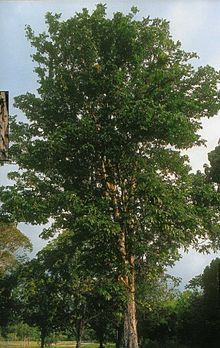Carapa guianensis
You can help expand this article with text translated from the corresponding article in Dutch. (June 2014) Click [show] for important translation instructions.
|
| Carapa guianensis | |
|---|---|

| |
| Scientific classification | |
| Kingdom: | |
| (unranked): | |
| (unranked): | |
| (unranked): | |
| Order: | |
| Family: | |
| Genus: | |
| Species: | C. guianensis
|
| Binomial name | |
| Carapa guianensis | |
Carapa guianensis is a species of the family Meliaceae (Mahogany family). The tree grows in the Amazon region, Central America and the Caribbean. It is a tall tree with dense foliage, which usually grows in the tropical rain forest along the edge of rivers. The wood resembles mahogany and is used in quality furniture. From the seeds is derived a plant oil which have medicinal properties. Also, the oil is used as a repellent against insects.[1][2][3][4][5][6][7][8][9]

Oil

The oil contained in the andiroba almond is light yellow and extremely bitter. When subjected to a temperature below 25 °C, solidifies, leaving consistency like that of petroleum jelly. Contains substances like olein, palmitine and the glycerin.
The oil is used in Brazil as a furniture from termites and other wood-chewing insects.[10][11]
References
- ^ Roy, A., et al. “Limonoids: overview of significant bioactive triterpenes distributed in plants kingdom. Biol. Pharm. Bull. 2006; 29(2): 191-201.
- ^ de Mendonca, F. A., et al. “Activities of some Brazilian plants against larvae of the mosquito Aedes aegypti.” Fitoterapia. 2005 Dec; 76(7-8): 629-36.
- ^ Silva, O. S., et al. “The use of andiroba Carapa guianensis as larvicide against Aedes albopictus.” J. Am. Mosq. Control Assoc. 2004 Dec; 20(4): 456-7.
- ^ Miot, H. A., et al. “Comparative study of the topical effectiveness of the Andiroba oil (Carapa guianensis) and DEET 50% as repellent for Aedes sp.” Rev. Inst. Med. Trop. Sao Paulo. 2004 Sep-Oct; 46(5): 253-6.
- ^ Konan, Y. L., et al. “Comparison of the effect of two excipients (karite nut butter and vaseline) on the efficacy of Cocos nucifera, Elaeis guineensis and Carapa procera oil-based repellents formulations against mosquitoes biting in Ivory Coast.” Parasite. 2003 Jun; 10(2): 181-4.
- ^ Sylla, M., et al. “Evaluation of the efficacity of coconut (Cocos nucifera), palm nut (Eleais guineensis) and gobi (Carapa procera) lotions and creams in individual protection against Simulium damnosum S.L. bites in Cote d'Ivoire.” Bull. Soc. Pathol. Exot. 2003 May; 96(2): 104-9.
- ^ Gilbert, B., et al. "Activities of the Pharmaceutical Technology Institute of the Oswaldo Cruz Foundation with medicinal, insecticidal and insect repellent plants." An. Acad. Bras. Cienc. 1999; 71(2): 265-71.
- ^ Mikolajczak, K. L., et al. “A limonoid antifeedant from seed of Carapa procera.” J. Nat. Prod. 1988; 51(3): 606-10
- ^ Titanji, J. P., et al. “Novel Onchocerca volvulus filaricides from Carapa procera, Polyathia suaveolens and Pachypodanthium staudtii.” Acta. Leiden. 1990; 59: (1-2) 377-82.
- ^ Hammer, M. L., et al. “Tapping an Amazonian plethora: four medicinal plants of Marajó Island, Pará (Brazil).” J. Ethnopharmacol. 1993 Sep; 40(1): 53-75.
- ^ Cohen, E., et al. “Cytotoxicity of nibolide, epoxyazadiradione and other liminoids from neem insecticide.” Life Sci. 1996; 58(13): 1075-81.
